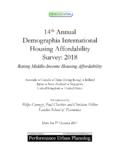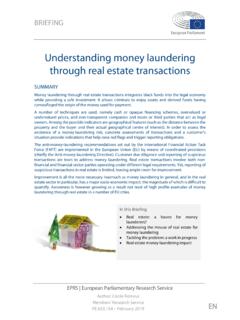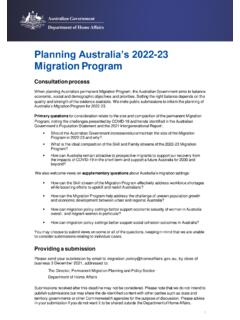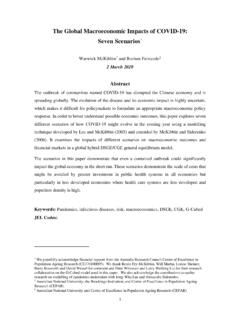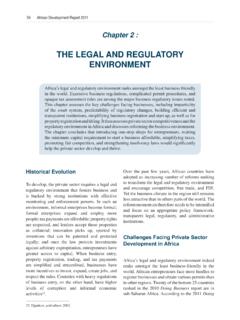Transcription of Is migration good for the economy? - OECD
1 May 2014. The economic impact of migration has been intensively studied but is still often driven by ill-informed perceptions, which, in turn, can lead to public antagonism towards migration . These negative views risk jeopardising efforts to adapt migration policies to the new economic and demographic challenges facing many countries. This edition of migration Policy Debates looks at the evidence for how immigrants affect the economy in three main areas: The labour market, the public purse and economic growth. _____. Is migration good for the economy? migration is a feature of social and economic life across many countries, but the profile of migrant populations varies considerably.
2 In part this is because of the variety of sources of migration . In much of Europe, for example, citizens enjoy extensive rights to free movement. In Australia, Canada and New Zealand, managed labour migration plays an important role. Other sources include family and humanitarian migration . Whatever its source, migration has important impacts on our societies, and these can be controversial. The economic impact of migration is no exception. Benefit or burden what's the reality? To answer this question, it can be helpful to look at migration 's impact in three areas the labour market, the public purse and economic growth.
3 Labour markets Migrants accounted for 47% of the increase in the workforce in the United States and 70% in Europe over the past ten years. Migrants fill important niches both in fast-growing and declining sectors of the economy. Like the native-born, young migrants are better educated than those nearing retirement. Migrants contribute significantly to labour-market flexibility, notably in Europe. The public purse Migrants contribute more in taxes and social contributions than they receive in benefits. Labour migrants have the most positive impact on the public purse.
4 Employment is the single biggest determinant of migrants' net fiscal contribution. economic growth migration boosts the working-age population. Migrants arrive with skills and contribute to human capital development of receiving countries. Migrants also contribute to technological progress. Understanding these impacts is important if our societies are to usefully debate the role of migration . Such debates, in turn, are essential to designing policies in areas like education and employment that maximise the benefits of migration , especially by improving migrants' employment situation.
5 This policy mix will, of course, vary from country to country. But the fundamental question of how to maximise the benefits of migration , both for host countries and the migrants themselves, needs to be addressed by many OECD countries in coming decades, especially as rapid population ageing increases demand for migrants to make up shortfalls in the workforce. migration Policy Debates OECD May 2014 1. Migrant workers make important At the same time, immigrants represented about a contributions to the labour market in both quarter of entries into the most strongly declining high- and low-skilled occupations occupations in Europe (24%) and the United States (28%).
6 In Europe, these occupations include craft Over the past ten years, immigrants represented and related trades workers as well as machine 47% of the increase in the workforce in the United operators and assemblers; in the United States, States, and 70% in Europe (OECD, 2012). Across they concern mostly jobs in production, installation, OECD countries, only a relatively small part of these maintenance and repair. In all these areas, workforce entrants came through managed labour immigrants are filling labour needs by taking up migration (which represents only a fraction of all jobs regarded by domestic workers as unattractive movements to the OECD), and more came through or lacking career prospects.
7 Other channels, including family, humanitarian and free-movement migration . In Europe free movement migration helps Changes in the tertiary-educated labour force, address labour market imbalances 2000-10 by source Millions In Europe, the scope of labour mobility greatly increased within the EU/EFTA zones following the EU enlargements of 2004 and 2007. This added to labour markets' adjustment capacity. Recent estimates suggest that as much as a quarter of the asymmetric labour market shock that is occurring at different times and with different intensities across countries may have been absorbed by migration within a year (Jauer et al.)
8 , 2014). Migrants contribute more in taxes and social contributions than they receive in individual Sources: European countries: European Labour Force Surveys (Eurostat), 2000. and 2010; United States: 2000 Census and American Community Survey 2010; benefits Canada: Survey of Labour and Income Dynamics, 1998-2008. Recent work on the fiscal impact of migration for all The education status of immigrants varies European OECD countries, as well as Australia, considerably. Just like the relationship between Canada and the United States, has provided new younger and older native-born people, young and internationally comparative evidence (Liebig immigrants are generally much more educated and Mo, 2013).
9 The study suggests the impact of than immigrants nearing retirement. This is also the cumulative waves of migration that arrived over true for immigrants entering the labour force: on the past 50 years in OECD countries is on average average over a third are tertiary-educated. The close to zero, rarely exceeding of GDP in same proportion, however, has not completed their either positive or negative terms. The impact is upper-secondary education. Since 2000/01, highest in Switzerland and Luxembourg, where immigrants have represented 31% of the increase immigrants provide an estimated net benefit of in the highly educated labour force in Canada, 21% about 2% of GDP to the public purse.
10 In the United States and 14% in Europe. Immigrants are thus neither a burden to the public Even though most migration is not directly driven purse nor are they a panacea for addressing fiscal by workforce needs, immigrants are playing a challenges. In most countries, except in those with significant role in the most dynamic sectors of the a large share of older migrants, migrants contribute economy. New immigrants represented 22% of more in taxes and social contributions than they entries into strongly growing occupations in the receive in individual benefits. United States and 15% in Europe.

